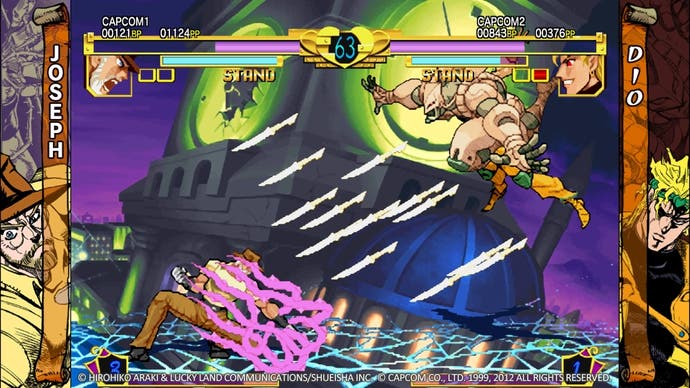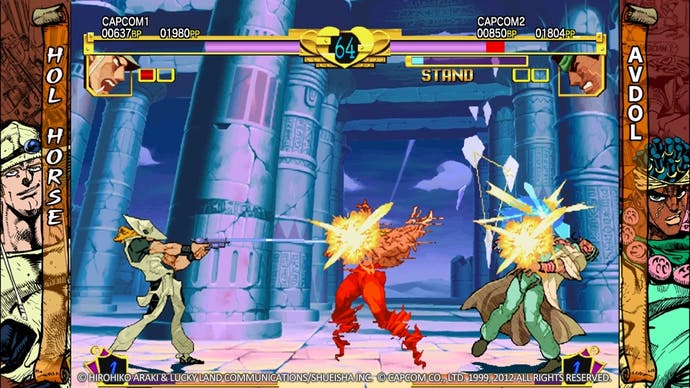Jojo's Bizarre Adventure HD Ver. Review
Irregular Joe.
Ryu and Ken are Capcom's flagship fighters, no question, but the Osaka-based developer has more than just tiger knees and sonic booms to its name. It's responsible for the open arenas of Power Stone, the warring academics of Rival Schools, the 3D ring-outs of Star Gladiator and the levelling-up system of Red Earth. This last one is particularly poignant, as while Red Earth was the first game for the CPS-3 (a short-lived arcade board that focused on pixel rendering in a time when polygons were taking over), Jojo's Bizarre Adventure was the sixth and final CPS-3 game before Capcom switched to the Taito Type X.
Dragon Ball Z and Naruto have a larger following in the West, but Bizarre Adventure ranks as one of longest-running manga series in Japan, having started in 1987 and still going strong today. Its story focuses on the mysterious bloodline of the Joestar family and their ability to summon spiritual guardians known as "Stands". Each chapter is set in a different period of time and, with the addition of bloodsucking vampires, JoJo's lives up to its offbeat name. It's also the perfect premise for a barmy fighting game.

Although Bizarre Adventure was ported to the Dreamcast, its anime styling and less conventional combat system didn't have the same tightness and nostalgic allure of Street Fighter 3. But while it can't compete with the upper echelon of fighting games, that doesn't detract from its status as one of Capcom's more polished experiments. The four buttons are divided between light, medium and heavy attack in addition to the aforementioned Stand ability. Each fight lasts for two rounds with a spacious super gauge that can hold up to 10 stocks, and an obligatory life bar that offers some insight into how well the fight is going.
On the face of it, the underlying mechanics seem fairly conventional when compared to the 2D fighter norm. You can perform four different jumps that include a short hop and an arcing leap; each character has an overhead attack that can bypass a crouching block; you can roll or advance block by pushing all three attacks buttons together; and special moves are performed with the usual charges and motions. But the way in which Bizarre Adventure distinguishes itself is with Stand system.
Most of the characters have a Stand that you can summon by tapping the appropriate button, and although they'll take damage if your Stand is hit, Stand mode opens up a range of character-specific moves and techniques. Jotaro Joestar, for instance, can use his Star Platinum to lay into the opponent like Fist of the North Star, while Polnareff can attack from both sides simultaneously with his rapier-wielding Silver Chariot. And while the temptation is to keep the Stand active at all times, you'll risk a Stand Crush if you take too many hits without recharging.

In execution, the Stand system offers a lot of tactical depth and variation among the 16 main characters. Fighters like the sword-wielding Chaca rely on Stand mode to mount a solid offense, while Jotaro and Polnareff do fairly well without it. Some characters also have passive Stands that are always active. This includes Mahrahia with her ability to magnetise the opponent like Iron Tager, the cowboy-ish Hol Horse with his guided projectiles and the infuriating Pet Shop with his ridiculous juggle combos. There's even one character that can turn the opponent into a child before beating them senseless.
It's the kind of risqué technique that's reminiscent of the gender-bending Midnight Bliss from Darkstalkers, and if there's one game that Bizarre Adventure resembles more than any other - at least on a stylistic level - it's definitely Capcom's monster mash-up. If the fortunes of the CPS-3 had been different, we suspect Darkstalkers 4 would've looked a lot like this. You could even argue that JoJo's stages, which range from vampire tombs to sand-stricken ghost towns, could accommodate the likes of Demitri and Morrigan without looking suspiciously out of context.
But as an HD remake of a 14-year-old arcade game, how does Bizarre Adventure stack up against the wealth of 2D fighting games already available on PSN and Xbox Live? Well, in terms of cosmetic nips and supplementary tucks, this is considerably more bare-bones than Street Fighter 3: 3rd Strike Online Edition. There's no way to bypass the widescreen boarders but you can choose between original pixels or a new high-definition mode that smooths everything out. It's down to personal preference, of course, but the original blocks hold so much character that we wouldn't play any other way.

The other thing to note is the limited range of game modes. There's the generously titled Story Mode that's lacking in content compared to the mini-game-infested Super Story Mode from the PS1 version. There's the Challenge Mode that lets you choose between a health or super boost between fights. And there's the Training room that's equipped with the usual dummy recording settings. Aside from a couple of bonus stages where you have to fight a death-like character and walk through a desert filled with watery hands, that's pretty much it.
Your online options are marginally more open-ended, with Ranked and Player Matches in addition to a lobby system that can be customised with private slots and room names like "looking for a teacher". And while it's not the smoothest fighter on the market in terms of lag reduction, it manages to offer a slightly more stable environment than the GGPO-based netcode used in Online Edition. Just don't expect miracles if you fight someone living in Japan.
In summary, Bizarre Adventure is a classic fighter that's been revived with both a functional online component and a visual upgrade that's arguably unnecessary. It doesn't have the technical combo trials, engaging challenges or funky intro beat of Online Edition, but it's a solid re-release that makes a good if not exceptional fighting game more accessible to those who might not have experienced it the first time round. So how much does it cost to play this game on a modern console? A whopping £15.99 or 1600 Microsoft points.

The review score below does not reflect the price of the game, but I find it astonishing that Capcom would be willing charge more for this than Online Edition. It's understandable that fewer people will buy Bizarre Adventure because of its relative obscurity, but when the game is scarcely any different to the Dreamcast version, the asking price doesn't seem justifiable unless Capcom employed a herd of unicorns to oversee the port. You can't even select which stage to fight on; it's always randomised.
But whatever your view on the cost, rest assured that Jojo's Bizarre Adventure is a genuinely interesting fighting game that was released at a time when accessibility played second fiddle to mechanical depth and combos that demanded a high level of execution. The HD subtitle doesn't add up to a lot in this case, but that shouldn't detract from a 2D fighter that's as much lost treasure as it is bizarre curio.









